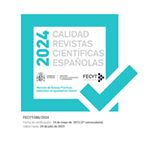Familiar, retórica, cortesana: disfraces de la carta en los tratados epistolares renacentistas
Abstract
The purpose of this article is to explore the three main theoretical points of view about the letter (clearly differentiated, although not necessarily one against the other) that appear in Renaissance treatises. In a first type of manuals, the letter is seen like a familiar text, near the common language and equated to a carefree and spontaneous conversation between friends. In the opposed pole, the letter can be also understood like a rhetorical, skillful document, composed in agreement with the same norms that govern the composition of the oratio or oral speech. Besides these two ideas of the epistle, familiar and rhetoric, both born in neo-latin humanism, a new conception arises in the second half of 16th century, in the context of an abundant corpus of letter formularies and manuals for secretaries written in the vernacular tongues: the conception that considers the epistle like the expression of the courtly or courteous society and spirit.Downloads
Article download
License
In order to support the global exchange of knowledge, the journal Cuadernos de Historia Moderna is allowing unrestricted access to its content as from its publication in this electronic edition, and as such it is an open-access journal. The originals published in this journal are the property of the Complutense University of Madrid and any reproduction thereof in full or in part must cite the source. All content is distributed under a Creative Commons Attribution 4.0 use and distribution licence (CC BY 4.0). This circumstance must be expressly stated in these terms where necessary. You can view the summary and the complete legal text of the licence.












